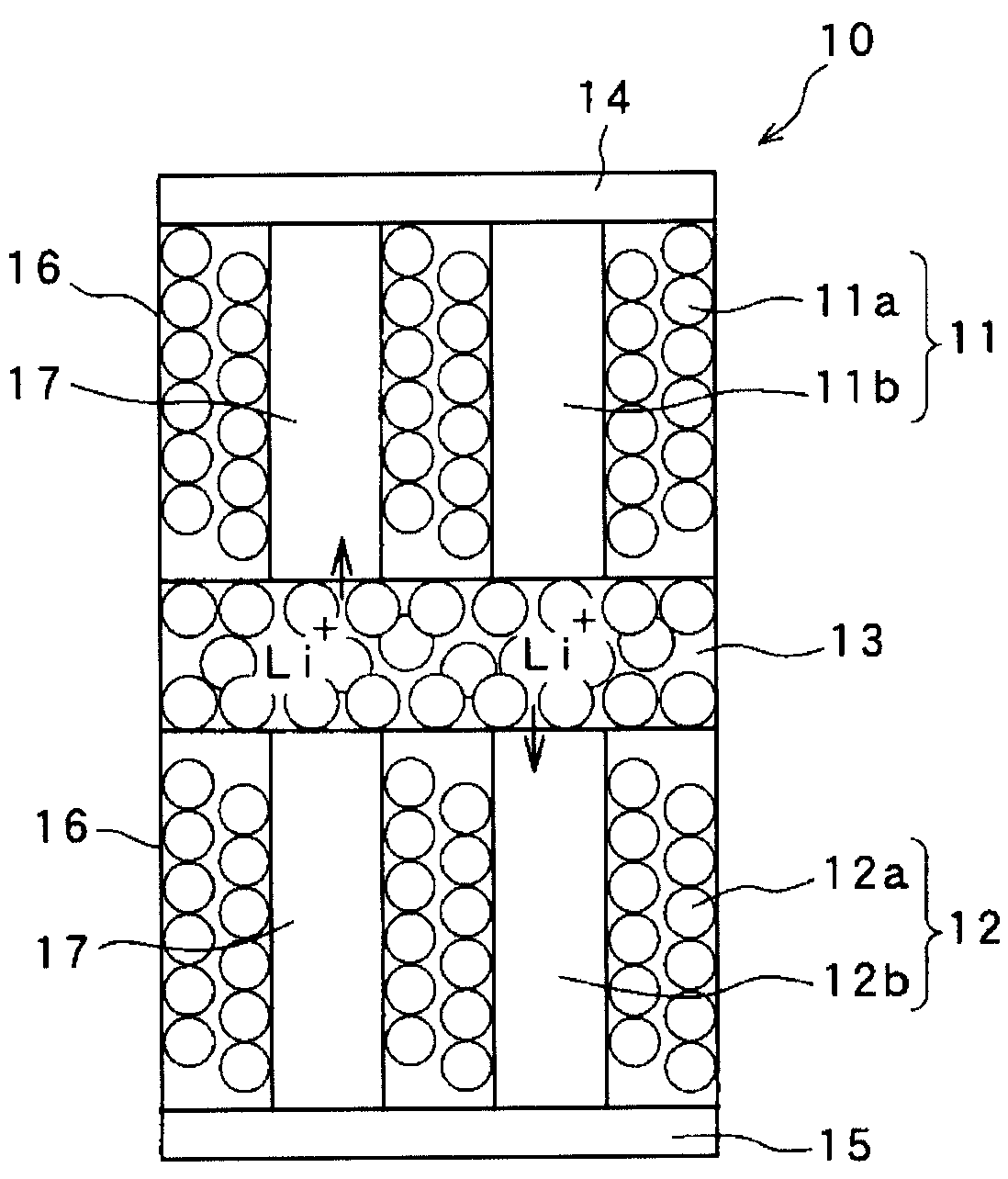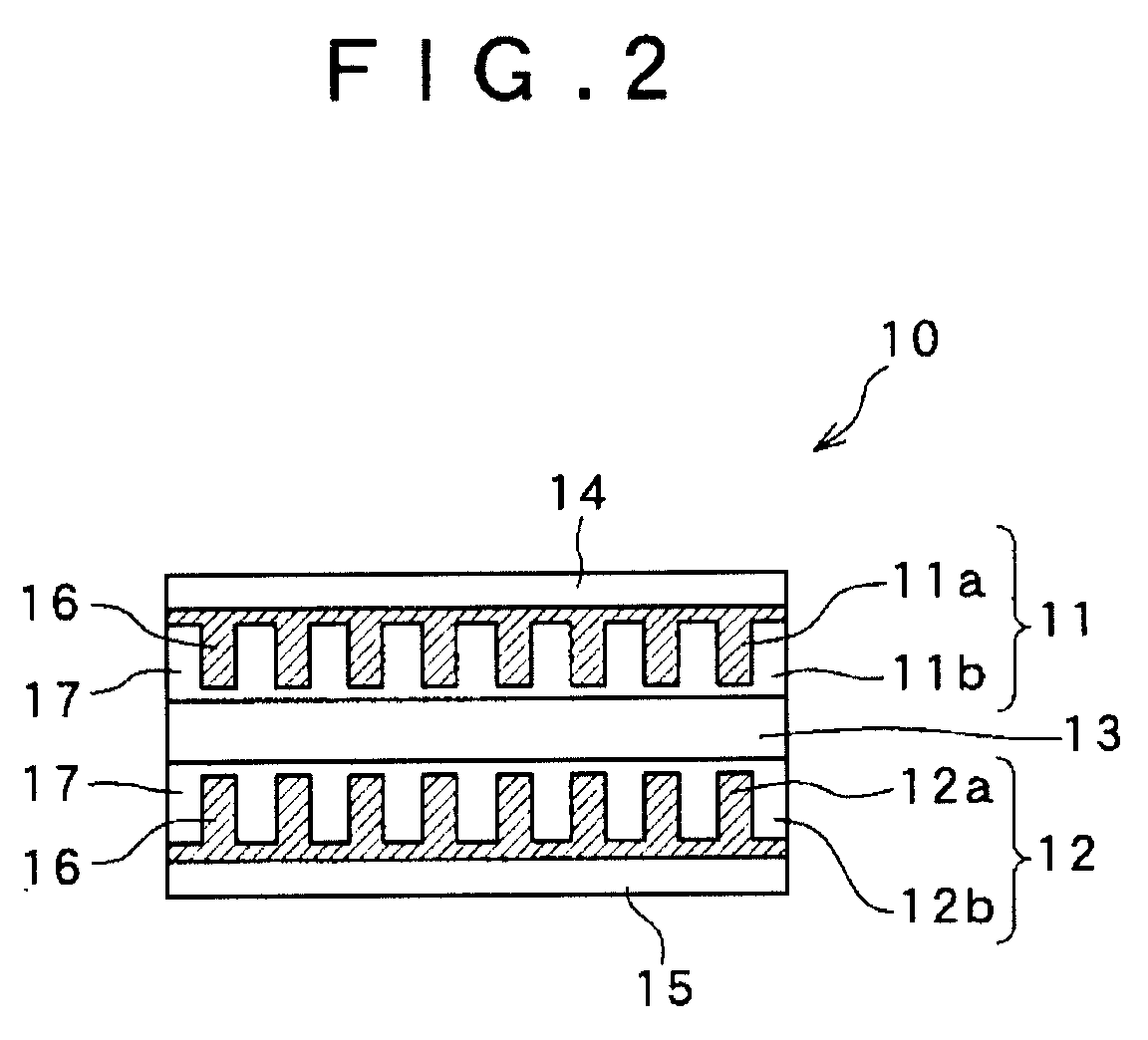Solid battery and a method for manufacturing an electrode thereof
a solid battery and manufacturing method technology, applied in the direction of sustainable manufacturing/processing, non-aqueous electrolyte cells, cell components, etc., can solve the problems of long time-consuming battery reaction, difficult to provide a battery with a high current output, and difficult to obtain a high current density, etc., to achieve high current density, high current output, and shorten the distance of diffusion of ions and electrons
- Summary
- Abstract
- Description
- Claims
- Application Information
AI Technical Summary
Benefits of technology
Problems solved by technology
Method used
Image
Examples
example 1
Production of Powder of Amorphous Oxide Glass
[0111]As raw materials, HaPO4, Al(PO3), Li2CO3, SiO2 and TiO2 were used. These raw materials were weighed to obtain a composition in mol % on oxide base having 35.0% P2O5, 7.5% Al2O3, 15.0% Li2O, 38.0% TiO2 and 4.5% SiO2. The raw materials were mixed uniformly and then put in a platinum pot. The raw materials were heated and melted while being stirred in an electric furnace at 1500° C. for three hours to provide molten glass.
[0112]Then, the molten glass was dripped into flowing water at room temperature from a platinum pipe attached to the platinum pot while the molten glass was heated and the molten glass thereby was promptly cooled to provide an oxide glass.
[0113]This glass was crystallized in an electric furnace at 1000° C. and lithium ion conductivity was measured. The lithium ion conductivity was 1.3×10−3 S cm−1 at room temperature.
[0114]By the powder X-ray diffraction method, the precipitating crystal phase was examined and it was c...
example 2
[0131]An electrolyte green sheet was prepared in the same manner as in Example 1.
Preparation of a Positive Electrode Precursor
[0132]As a positive electrode active material, lithium manganate made by Honjo Chemical was milled to powder having an average particle diameter of 0.5 μm and this powder was mixed and dispersed with an acrylic binder and a dispersing agent by using water as a solvent to provide a positive electrode slurry.
[0133]In the same manner as in Example 1, the electrolyte slurry and the positive electrode slurry were respectively formed in the form of a line alternately on a release film through quarts glass capillaries having an inner diameter of 0.2 mm and these alternately disposed lines of slurries were dried.
[0134]Then, platinum was deposited on these lines by sputtering and the lines were stacked together by rolling these lines and a stack having a circular cross section was provided. This stack having a circular cross section had an outer diameter of φ9 mm.
[013...
example 3
Preparation of a Positive Electrode-Electrolyte-Negative Electrode Laminate
[0143]A sheet of the negative electrode precursor using lithium titanium and a sheet of the electrolyte green sheet prepared in Example 1 and a sheet of the positive electrode precursor prepared in Example 2 were superposed one upon the other and laminated together by pressing them with a hot press at 120° C. and 50 kgf. The laminate then was pressed at room temperature by using CIP (cold isotropic pressure pressing) for tightening. The laminate then was held with an aluminum setter and heated in an electric furnace at 400° C. for removing organic substance such as a binder and a dispersing agent. Then, the temperature was lifted quickly to 900° C. and the laminate was held there for 5 minutes. Then the laminate was cooled to provide a sintered laminate of a positive electrode, an electrolyte and a negative electrode.
[0144]A part of the sintered laminate was cut off and polished and observed with a scanning e...
PUM
| Property | Measurement | Unit |
|---|---|---|
| particle diameter | aaaaa | aaaaa |
| width | aaaaa | aaaaa |
| width | aaaaa | aaaaa |
Abstract
Description
Claims
Application Information
 Login to View More
Login to View More - R&D
- Intellectual Property
- Life Sciences
- Materials
- Tech Scout
- Unparalleled Data Quality
- Higher Quality Content
- 60% Fewer Hallucinations
Browse by: Latest US Patents, China's latest patents, Technical Efficacy Thesaurus, Application Domain, Technology Topic, Popular Technical Reports.
© 2025 PatSnap. All rights reserved.Legal|Privacy policy|Modern Slavery Act Transparency Statement|Sitemap|About US| Contact US: help@patsnap.com



